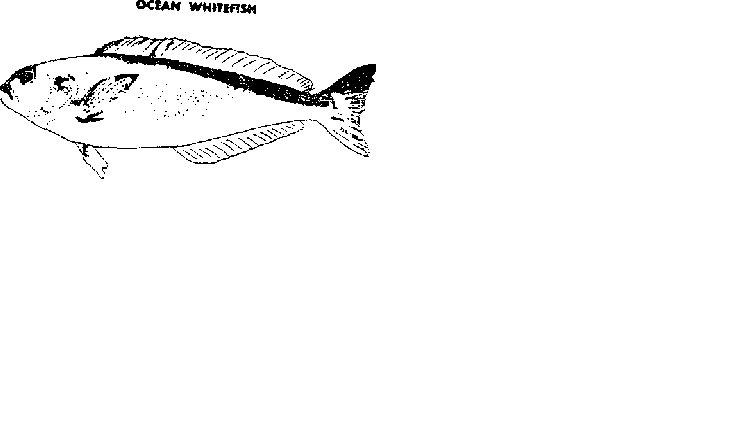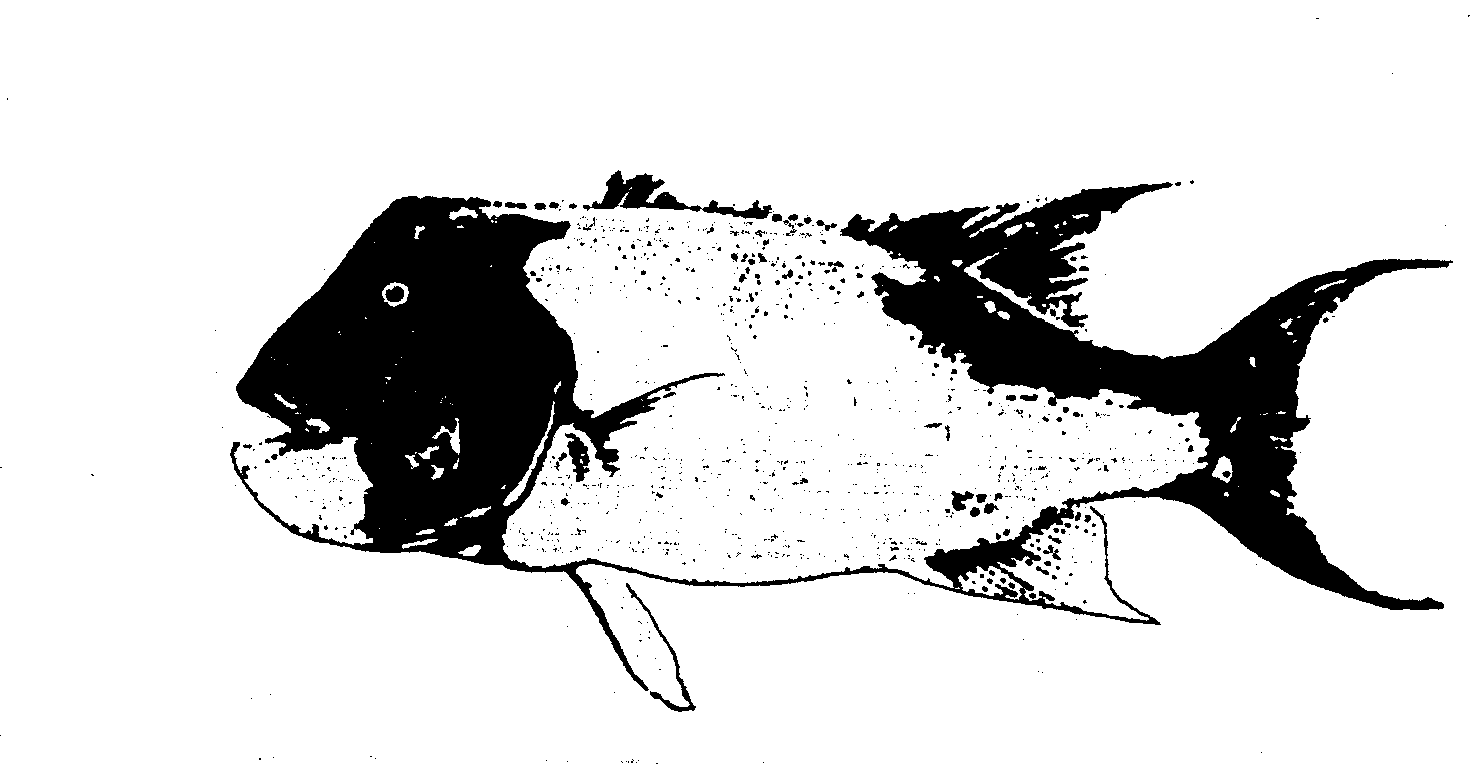
- •Offshore fishes
- •Sanddabs
- •California halibut
- •4 Kelp bass
- •California barracuda
- •California yellowtail
- •7 Pacific jack mackerel Trachurus symmetricus
- •8 Pacific mackerel Scomber japonicus
- •9 California bonito (Sarda chiliensis)
- •10 Tuna, bluefin
- •11 Albacore
- •12 White seabass
- •13 White croaker Genyonemus lineatus
- •14 Ocean whitefish
- •15 Sheep-head
- •1 6 Bocaccio Sebastes paucispinis
- •17 Olive rockfish
14 Ocean whitefish

Distinguishing characteristics. The ocean whitefish is the only member of the blanquillo family known in California waters. It is not related to the freshwater whitefish which is close relative of the salmons and trouts. The very long dorsal fin that is about the same height for entire length, the long anal fin of even height and the brownish-green or olive colored body covered with quite small scales usually distinguish ocean white-fish from any other fish that might be caught in our ocean waters. Whitefish sometimes are mistaken for yellowtail by "first-time” fishermen.
Distribution. Ocean white fish have been caught from fort Bragg south to the tip of Baja California and then northward throughout the Gulf of California. The same, or very similar, species is found off the coast of Equador, Peru, and Chile and offshore around the Galapagos Islands. They prefer living at depths of 30 to at least 300 feet where the bottom is rocky.
Life history notes. Weights of nearly 20 pounds have been reported for ocean whitefish, but recent interviews with market fishermen indicate that 12 pounds and 40 inches might be a maximum weight and length. Individuals weighing 8 to 10 pounds are extremely rare in the commercial catch, with three to six pounds the usual. Authenticated weights and lengths of ocean whitefish in excess of 10 pounds are badly needed.
When ocean whitefish are six years old they are 20 or 21 inches long and weight between three and four pounds. A 7.5-pounder was 25.5 inches long and appeared to be 13 years old. Some spawning probably takes place during the fall, winter, and spring. Larval ocean whitefish have been captured in plankton nets many miles offshore and young specimens just over an inch long have been found in the stomachs of albacore. These pelagic stages of the whitefish look entirely different from the aduls, having a number of ridges, on the sides and tops of their heads. They probably move inshore at an early age because 2.5-inch-long specimens, which closely resemble adults, have been captured near shore in shallow water.
Examination of a number of stomachs shows that ocean white- fish will eat just about everything they are able to get their mouths around - especially crabs, shrimp, and other crustaceans. Small octopi, squid and an assortment of fish are also regularly fed upon.
----------------------
Can-could-may-might-be able to-must-need-be needed.
Say-appear-know-estimate-report-think-believe-find-prove. Inhabit-reside-range-show up-hang out-prefer-occur-encounter-abound-be plentiful-took-tell apart-verify-authenticate-study-observe-discover-reveal-measure—reach-attain-approach- prey upon.
15 Sheep-head

Distinguishing characteristics. The sheep-head is one of three members of the wrasse family that lives in the waters off our State. Their body color at all stages, ages, and sexes serves to distinguish them from the other two kinds of wrasses. Young sheep-head of both sexes are a solid orange-red color except for seven roundish black blotches, five of which show in side view on the fins and the base of the tail. Adult females are a red or rose color and adult males both have a bluish-black head and tail and a red midsection. Adult males and females both have light or whitish "chin".

FEMALE SHEEPHEAD
Distribution. Sheep-head are not abundant north of Point Conception, but have been taken from Monterey Bay south to Cape San Lucas, Baja California, and north from there throughout much of the Gulf of California. They are found near the bottom in rocky areas, particularly where beds abound. They are most numerous at depth of 20 to 100 feet, but are occasionally caught in shallower or deeper water.
Life history notes. A male sheep-head speared off Pt. Loma during November 1956 weighed 36 pounds, but most of those caught on our coast weigh less than 15. A 29-pound male taken at Santa Cruz Island in May 1960 was 32 inches long and 53 years old, judging from the age rings of the scales. An 18-pound female, the largest female for which we have a record, speared off Laguna Beach in August 1961, was 30 years old. One old timer lived on Steinhart Aquarium, San Francisco, for 23 years befire dying.
Examination of scales and otoliths to determine age, and gonads for naturity, indicates that sheep-head probably first spawn when four or five years old. Most spawning takes place during the summer and the eggs are believed to be free-floating.
Skin divers sometimes report the same sheep-head “hanging around” a particular reef or other underwater landmark during several years. Similar reports are so frequent that we assume that sheep-head do not travel very much, particularly as large adults.
They have a reputation among commercial fishermen for being quite destructive to lobsters and abalones. Underwater observations and an examination of the stomach contents of a few individuals indicate that they also feed heaveku upon barnacles, sea urchins, mussels, and crabs. Enemies of the sheep-head, however, appear to be few in number. On several occasions, medium-sized sheep-head have been found in the stomachs of large giant sea bass.
Fossilized bones and teeth of sheep-head have been found in a number Pleistocene and Pliocene deposits throughout Southern California. Some of these are thought to hace been laid down as long ago as 20,000,000 years.
Belong-make_up-hold-use-lay-lie-extend-remain-move-remove-increase-come-go-join-confine-enter-exist-begin-depend on-mistake-look-help-give-last-rise-spend-compare-return-run-recognize-travel-release-be ready-float-swim-lose-stay.
